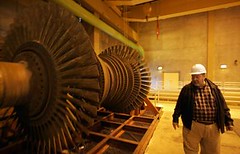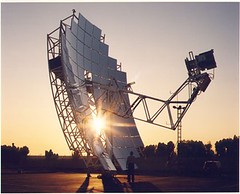
From a rural outpost in Ripton, Vermont, Bill McKibben has been waging a tireless campaign against global warming. He started back when only a handful of people were even discussing the issue; the publication of his book, The End of Nature, in 1989 clarified many of the concepts that only today have become almost universally embraced.
McKibben is now working to energize people around the globe to make the necessary changes to avert what he sees as an accelerating disaster, the magnitude of which dwarfs all our other social problems. His Step It Up activities in 2007 rallied a large part of the nation to the cause. But, McKibben's message in 2008, articulated in a recent Yes! magazine article, First, Step Up, is that global warming is happening faster than expected and an enormous social movement will be needed to stop it.
McKibben gave some examples to suggest the scale of the problem:
What exactly do I mean by large? Last fall the scientists who study sea ice in the Arctic reported that it was melting even faster than they’d predicted. We blew by the old record for ice loss in mid-August, and by the time the long polar night finally descended, the fabled Northwest Passage was open for navigation for the first time in recorded history. That is to say, from outer space the Earth already looks very different: less white, more blue.
What do I mean by large? On the glaciers of Greenland, 10 percent more ice melted last summer than any year for which we have records. This is bad news because, unlike sea ice, Greenland’s vast frozen mass sits above rock, and when it melts, the oceans rise—potentially a lot. James Hansen, America’s foremost climatologist, testified in court last year that we might see sea level increase as much as six meters—nearly 20 feet—in the course of this century. With that, the view from space looks very different indeed (not to mention the view from the office buildings of any coastal city on earth).
What do I mean by large? Already higher heat is causing drought in arid areas the world over. In Australia things have gotten so bad that agricultural output is falling fast in the continent’s biggest river basin, and the nation’s prime minister is urging his people to pray for rain. Aussie native Rupert Murdoch is so rattled he’s announced plans to make his NewsCorp empire (think Fox News) carbon neutral. Australian voters ousted their old government last fall, largely because of concerns over climate.
The answer, McKibben thinks, is in building the largest social movement ever known.
Most of all, we need a movement. We need a political swell larger than the civil rights movement—as passionate and as willing to sacrifice. Without it, we’re not going to best the fossil fuel companies and the auto-makers and the rest of the vested interests that are keeping us from change.
Some of us have spent the last couple of years trying to build that movement, and we’ve had some success. With no money and no organization, seven of us launched StepItUp in January 2007. Before the year was out, we’d helped organize 2,000 demonstrations in all 50 states—and helped take our once-radical demand for an 80 percent reduction in U.S. carbon emissions by mid-century into the halls of power.
The conclusion of the article manages to be optimistic. Despite the scope of the challenge, there are many actions we can take collectively and individually to spur the necessary change. But, it's clear we need to start now and the changes need to be deep. Fasten your seat belts; it's going to be a bumpy night.






